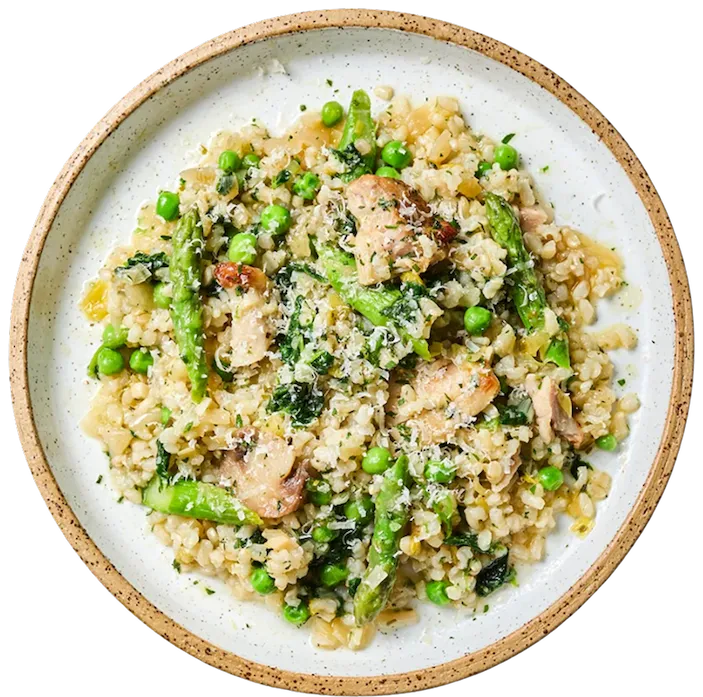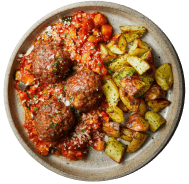Blue Zone Diet Tips
How To Follow A Blue Zone Diet
Live longer, healthier with a Blue Zone diet. But how exactly can you follow a Blue Zone diet at home? We share some easily incorporated tips on how to make small changes to your meals, with big health results.
Key food secrets of the world’s longest-lived people from 'blue-zone' countries. Laura Tilt summarises and shares her thoughts on an article written by Dan Buettner about what constitutes a blue zone diet. To read the full article click here
Give your meals a plant slant
Try to make 95% of your food intake from plant sources. This means choosing beans, greens, yams and sweet potatoes, fruits, nuts, seeds and wholegrains over meat. Whole grains are included too.
Blue Zone tips
- The best longevity vegetables are leafy greens such as spinach, kale, chard, and collards as they are high in polyphenols.
- Stock up on favourite fruits and vegetables on hand.You are more likely to eat those you like and if they are easy to access.
- Use olive oil like butter.Sauté vegetables over low heat in extra virgin olive oil and by drizzle extra virgin olive liberally over vegetables and salads.
- Buy whole grains. Oats, barley, brown rice, and ground corn are commonly included in Blue Zones diets around the world.
Laura's verdict You can't eat enough plant based foods as they are rich in fibre and phytonutrients. All the science supports plant heavy diets for a range of health outcomes (not just for healthy ageing).
Consume meat no more than twice a week.
Meat is eaten sparingly in the Blue Zones - they eat it less often and when the do, in small servings. They use meat as a celebratory food, a small side, or a way to flavour dishes rather than being the main event. The meat they eat also comes from free-roaming animals and is never processed.
Blue Zone tips
- Avoid processed meats like hot dogs or sausages
- Designate two days a week when you eat meat or other animal-derived food
- Portion sizes of meat should be around the size of a deck of cards
Laura's verdict
There is mounting evidence that high meat intake (especially from processed sources) is associated with higher risk of cancers. Eat it less often and buy free-range or organic to ensure good animal welfare and reduce impact on the environment.
Enjoy fish frequently
Fish is a common part of everyday meals, eaten on average two to three times a week in the Blue Zones.The Adventist Health Study 2, which has been following 96,000 Americans since 2002, found that the people who lived the longest were not vegans or meat-eaters. They were “pesco-vegetarians,” or pescatarians, people who ate a plant-based diet including a small portion of fish, up to once daily.
Blue Zone tips
- Favour mid-chain fish like trout, snapper, grouper, sardines, and anchovies. To replicate a Blue Zones diet, avoid predator fish like swordfish, shark, or tuna as they are high in mercury or PCBs.
• Make ethical choices and avoid overfished species.
• Steer clear of “farmed” fish, as they are typically raised in overcrowded pens that make it necessary to use antibiotics, pesticides, and coloring.
Laura's verdict
Fish does play a key role in a healthy diet as a source of lean protein and omega-3 fats. Seaspiracy has raised concerns around whether there is such a thing as sustainable fishing. Do your homework on where your fish comes from and choose Marine Stewardship Council label fish (it is the best we have available at present).
Keep an eye on dairy and egg intake
Cow’s milk does not figure significantly in any Blue Zones diet except that of the Adventists, some of whom eat eggs and dairy products. Eggs are consumed in all five Blue Zones diets, where people eat them an average of two to four times per week.
Blue Zone tips
- Cut down your consumption of cow’s milk and dairy products such as cheese, cream, and butter. Try unsweetened soy, coconut, or almond milk as a dairy alternative.
- Boost you calcium from vegetable sources too. One cup of cooked kale or two-thirds of a cup of tofu, for instance, provides just as much bioavailable calcium as a cup of milk.
- Don’t overeat on eggs
Laura's verdict
Dairy is an excellent source of calcium and other nutrients so a dairy free diet does come with nutritional risks. If choosing dairy alternatives please check they are fortified with calcium. When it comes to dairy and eggs the good old rule of 'in moderation' applies well.
Daily Dose of Beans
Eat at least a half cup of cooked beans daily. Beans are the cornerstone of every Blue Zones diet in the world: black beans in Nicoya; lentils, garbanzo, and white beans in the Mediterranean; and soybeans in Okinawa. The long-lived populations in these blue zones eat at least four times as many beans as we do, on average.
Blue Zone Tips
- Find ways to cook beans that taste good to you and your family. If you don’t have favourite recipes already, resolve to try three bean recipes over the next month
- Use pureed beans as a thickener to make soups creamy and protein-rich.
- Make salads heartier by sprinkling cooked beans onto them. Serve hummus or black bean cakes alongside salads for added texture and appeal.
Laura's Verdict
Beans should be your new best friend. They are a great source of fibre for your gut bacteria and research has found that eating just 20 grams of beans daily can reduce a person’s risk of dying in any given year by about 8%. Add them to stews, your bolognese sauce, salads and soups. They might make you gassy at first but give it time for your digestive system to settle.
Slash Sugar
Keep sugar as a treat. Centenarians typically eat sweets only during celebrations. Their foods have no added sugar, and they typically sweeten their tea with honey.
Blue Zone tips
- Consume sweets as a celebratory food. Limit desserts or treats to 100 calories.
- Consider fruit your sweet treat in an at-home Blue Zones diet. Eat fresh fruit rather than dried fruit. Fresh fruit has more water and makes you feel fuller with fewer calories.
- Watch out for processed foods with added sugar, particularly sauces, salad dressings, and ketchup. Many contain several teaspoons of added sugar.
Laura's verdict
We all eat too much refined sugar - not knowingly - but as added sugar in the processed foods we buy. Start reading labels and avoiding these 'hidden' sugars'. Your palate will adjusts when you cut sugar and you will start finding things taste too sweet.
Snack On Nuts
Eat two handfuls of nuts per day. Nut-eaters on average outlive non-nut-eaters by two to three years, according to the Adventist Health Study 2.
Nut-eaters on average outlive non-nut-eaters by two to three years, according to the Adventist Health Study 2. Other studies show that diets with nuts reduce “bad” LDL cholesterol by 9% to 20%, regardless of the amount of nuts consumed or the fat level in them. Other healthful ingredients in nuts include copper, fiber, folate, vitamin E, and arginine, an amino acid.
Blue Zone tips
- Keep nuts around your workplace for mid-morning or mid-afternoon snacks. Take small packages for travel and car trips.
- Try adding nuts or other seeds to salads and soups.
- Stock up on a variety of nuts to include in your Blue Zones diet. The optimal mix: almonds (high in vitamin E and magnesium), peanuts (high in protein and folate, a B vitamin), Brazil nuts (high in selenium, a mineral thought to possibly protect against prostate cancer), cashews (high in magnesium), and walnuts (high in alpha-linoleic acid, the only omega-3 fat found in a plant-based food).
Laura's verdict
Get nuts about nuts. We have become quite wary about nut allergies (rightfully so as they can make some people very ill) but if you don't have a nuts allergy try snack on some unsalted nuts every day for all the good fats and nutrients they contain.
Choose sourdough or whole wheat bread
Replace common bread with sourdough or 100% whole wheat bread. Bread in the Blue Zones diet is either whole grain or sourdough, each with its own healthful characteristics. Breads in Ikaria and Sardinia, for example, are made from a variety of 100% whole grains, including wheat, rye, and barley—each of which offer a wide spectrum of nutrients, such as tryptophan, an amino acid, and the minerals selenium and magnesium. Whole grains all have higher levels of fiber than most commonly used wheat flours. Interestingly, too, barley was the food most highly correlated with longevity in Sardinia.
Blue Zone tips
- If you’re going to eat bread, be sure it’s authentic sourdough bread like the ones they make in Ikaria. Sometimes called pain au levain, this slow-rising bread is made with lactobacteria as a rising agent, not commercial yeast.
- Try to make sourdough bread yourself, and make it from an authentic sourdough starter.
- Try a sprouted grain bread
- Choose whole-grain rye or pumpernickel bread over whole wheat: They have a lower glycemic index.
- Choose or make breads that incorporate seeds, nuts, dried fruits, and whole grains.
Laura's verdict
A proper wholegrain bread is a source of fibre, nutrients and is a good easy accompaniment to meal times. The more dense the bread the better!
Go Wholly Whole
Eat foods that are recognizable for what they are. Another definition of a “whole food” would be one that is made of a single ingredient, raw, cooked, ground, or fermented, and not highly processed. (Tofu is minimally processed, for example, while cheese doodles and frozen sausage dogs are highly processed.) Throughout the world’s blue zones and their diets, people traditionally eat the whole food.
Blue Zone tips
- Shop for foods at your local farmers markets or community-supported farms.
- Avoid factory-made foods.
- Avoid foods wrapped in plastic.
- Avoid food products made with more than five ingredients.
- Avoid pre-made or ready-to-eat meals.
Laura's verdict
I fully support a whole foods diet approach but many of us have busy lives. Don't put pressure on yourself to adopt a 100% whole foods diet over night. It's good to start looking at what you eat and realise how much of it is processed. And then to slowly start making food swaps and adopting some new recipes into your weekly routine.
Eat Super Blue Foods
Integrate at least three of these items into your daily Blue Zones diet to be sure you are eating plenty of whole food.
1. Beans—all kinds: black beans, pinto beans, garbanzo beans, black-eyed peas, lentils
2. Greens—spinach, kale, chards, beet tops, fennel tops
3. Sweet potatoes—don’t confuse with yams
4. Nuts—all kinds: almonds, peanuts, walnuts, sunflower seeds, Brazil nuts, cashews
5. Olive oil—green, extra-virgin is usually the best. (Note that olive oil decomposes quickly, so buy no more than a month’s supply at a time.)
6. Oats—slow-cooking or Irish steel-cut are best
7. Barley—either in soups, as a hot cereal, or ground in bread
8. Fruits—all kinds
9. Green or herbal teas
10. Turmeric—as a spice or a tea
Laura's verdict
I love all of these ingredients and have tried where possible to bring them into various field doctor meals. Variety is the spice of life so try to introduce these into your weekly meal routine.
related content
more content: Gut Health
browse our ranges.
choose from one of our ranges or personalise your own menu from 60+ meals.
- low FODMAP

- eat well, live well programme

- gluten free

- high protein

- weight management

- ibs

- lowest calorie

- lower carbs

- mediterranean

- smaller range

- pcos

- lean + lighter

- menopause

- heart healthy

- plans

- full menu

- gift cards
- take the quiz